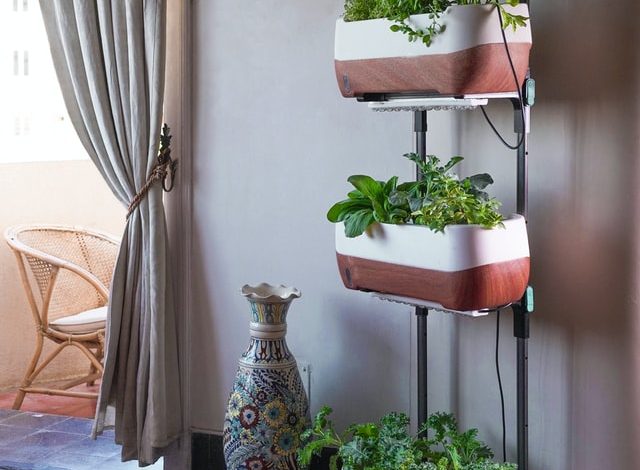How to Build an Indoor Vertical Vegetable Garden

Gardeners who are working with limited space often have to get creative to maximize their growth capabilities. Gardening options like hydroponic gardens and closed terrariums offer gardeners solidly effective ways to grow plants, flowers, fruits, vegetables, and herbs when they don’t have an outdoor space to use. Vertical gardens are another viable option that indoor gardeners can use, as well.
While vertical gardens are often used outdoors, they can also provide a great way to grow various plants and crops indoors. In this article, we’ll focus specifically on vegetables and how you can grow your favorites using the indoor vertical garden design.
What Are Vertical Gardens and Their Benefits?
The name “vertical gardens” itself implies what it is – a garden that grows vertically instead of horizontally. Vertical gardens can use various structures such as fencing, walls, poles, and more to grow; they are also used to produce a wide variety of plants and crops.
Gardeners choose this upward growing style for a variety of reasons. Here are some common reasons that vertical indoor gardens are grown and how they can benefit growing efforts:
- Space Saving – Because you don’t need a lot of width available on the ground, vertical gardens can be precisely what a gardener with limited space needs to still grow a decent amount. When a vertical garden is crafted correctly, it can take as little space as you design it to and potentially house a large quantity of plants and crops.
- Aesthetics – Indoor vertical gardens have this unique ability to brighten up any space. Depending on what you choose to grow, your vertical garden could add just the right amount of color to your space or liven up an otherwise dull area.
- Creativity – Your creative options for building a vertical garden are practically limitless. You can use any combination of things like shelving, ladders, pallets, wooden boxes, bottles, boards, and more to create your vertical garden.
- Convenience – Many gardeners enjoy some of the conveniences that vertical gardens have to offer. For instance, watering and tending to the garden can be easier because it eliminates the need to work close to the ground. Indoor vertical gardens also tend to be easily relocated as needed because the plants aren’t in the ground.
- Therapeutics and Health Benefits – There are various health and therapeutic benefits related to having live plants within your home. You may find that having an indoor garden helps you feel better and healthier overall.
- Seasonal Capabilities – By growing indoors with a vertical garden, you can grow the plants you want all year without the traditional impacts of outside weather systems and seasonal changes.
- Low Maintenance – Plants that are grown indoors can carry significantly less risk for fungal, weed, or pest infestation; this means considerably less work for you.

What Vegetables Grow Best In Vertical Gardens?
Before you get started with building your vertical vegetable garden, you’ll need to determine what you want to grow in your new space. Fortunately, there’s a wide variety of vegetables to choose from that can grow well vertically. Here’s a look at some potential vegetable options for you to choose from:
- Lettuce
- Tomatoes
- Cabbage
- Greens
- Potatoes
- Radishes
- Carrots
- Beans
- Peppers
- Cucumbers
- Pumpkins
- Squash
- Pole beans
How to Build Your Own Indoor Vegetable Garden
Building an indoor vertical garden can be one of the simplest and most rewarding ways to grow the vegetables you love. Below, we’ve put together a step-by-step process to help you successfully build the indoor vertical garden of your dreams.
- Decide Where You’ll Grow – While you are growing indoors, the spot you pick to establish your indoor vertical vegetable garden is crucial. You’ll first want to make sure to grow away from any ceiling, wall, or floor vents in your home. Second, ensure that your plants will be grown in a properly lit area. Familiarize yourself with the lighting requirements for your vegetables and accommodate that by placing your vertical planter relative to where the natural light is in your home.
- Decide How You’ll Grow – Deciding how you want to grow your vegetables is the fun part. There are endless options for structuring your vertical garden, which gives you the creative opportunity to choose the style that best fits the interior of your home and what you’re trying to grow. We’ve listed some fun and practical vertical planter options below. Be sure to keep in mind the size you need in each planter for the vegetables you’re growing when you make your decision.
- Wall Pots – If you’re looking for a modern statement piece to add to any room, try vertical wall pots. Simply mount pots one over the other on your wall!
- Vertical Tin Hanging Planters – Spray paint old coffee tins, hook them one-over-the-other together and hang them from the ceiling for a unique and functional vertical garden. One of the best parts about utilizing this building format can be found through the watering process; simply water the top plant, and it can trickle down and water the plants below it.
- Pallet Vertical Garden – Pallets are often upcycled for various decor and building projects – indoor vertical vegetable gardens are no different. By stapling landscape fabric to the back of the pallet and then adding soil and vegetables in between the wood planks, you can be on your way to a lush vegetable garden in no time.
- Leaning Bookshelf Garden – Leaning bookshelves are built for more than just books; that’s right, you can establish your vegetable plants vertically right on the shelves. If you’re looking for a simple way to develop your vertical garden, this design choice may be perfect for you. Simply place garden pots on the shelves and plant your vegetables.
- Potted Wooden Trellis – A wooden trellis mounted directly to your wall can be a unique method for growing your vegetables vertically indoors. After your trellis is up, mount clay or tin pots, add your vegetables, and you’ve got a very stylish vertical garden to feature in your home.
- Ladder Garden – A ladder garden is another simple, effective, and great looking vertical garden design. Simply place your potted vegetables along the various steps of your ladder and enjoy!
- Converted Dresser – If you have an old dresser no longer in use, consider using it to build your indoor vertical vegetable garden.
- Shoe Organizer – A shoe organizer already comes pre-built with separate pockets you can use to house your individual vegetable plants. Shoe organizers are easy to hang and great for very compact spaces.
- Vertically Stacked Crates – If you have a little more room to spare indoors, consider stacking crates on top of each other to house your vegetable plants. This vertical garden design can add a country chic flair to your home.
- Add Soil – To establish the best growing conditions for your indoor vegetables, your soil should be a mix of vermiculite, perlite, and peat moss. This type of soil will help ensure your vegetables retain the most moisture during watering.
- Plant Your Vegetable Seeds – When planting your vegetable seeds, be sure not to plant them too deep into the soil. The general rule of thumb is to plant the seeds at a depth that is about three times the size of the seed’s width.
- Fertilize – Fertilizer can prove very important when growing vegetables indoors. It’s crucial that you provide your plants with the nutrients they need to grow healthy and strong. Following planting your seeds, add a healthy dose of fertilizer to each plant’s soil. Continue fertilizing as needed.
- Water and Maintain – It’s crucial that you water your plants regularly and keep them trimmed and healthy. While your plants should be allowed room to grow upward, you’ll want to avoid allowing them to grow outward too much. If you need insight into how much and how often to water your vegetables, consult our watering guide here.

Pro Tips
We want your garden to succeed as much as you do! We’ve listed some pro tips below that can help guide you to growing the tastiest vegetables possible right in the convenience of your own indoor vertical garden.
- If you’re growing plants that like to climb, like tomatoes and cucumbers, trellis support may be the best option to support this growth.
- Pay attention to how much space you’re placing between each plant. Consider how tall you expect plants to get and be sure to allow them that room. If your vegetable plants are too crowded together, they may not grow as well.
- Don’t get the stems and leaves of your vegetable plants wet when watering. Even though your plants are being grown indoors, they can still succumb to infection and disease. Water saturation can provide the perfect environment for disease to spread with your plants.
- While your indoor vegetables will need sunlight to grow, be careful not to place them near windows or doors during cold weather. Drafts and cold temperatures from outside can adversely affect your plant’s growth.
- Maintain your plants regularly. Trim and cut away old growth and dead leaves and keep the soil fresh and moist at all times.



